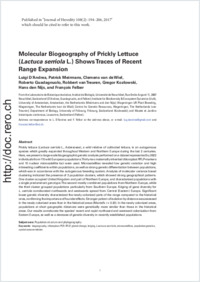Molecular biogeography of prickly lettuce (lactuca serriola l.) shows traces of recent range expansion
- D’Andrea, Luigi Laboratoire de Botanique évolutive, Institut de Biologie, Université de Neuchâtel,Switzerland
- Meirmans, Patrick Institute for Biodiversity and Ecosystem Dynamics (UvA), University of Amsterdam,The Netherlands
- Wiel, Clemens van de Wageningen UR Plant Breeding,The Netherlands
- Guadagnuolo, Roberto Laboratoire de Botanique évolutive, Institut de Biologie, Université de Neuchâtel,Switzerland
- Treuren, Robbert van Centre for Genetic Resources, Wageningen, The Netherlands
- Kozlowski, Gregor Department of Biology, University of Fribourg, Switzerland
- Nijs, Hans den Institute for Biodiversity and Ecosystem Dynamics (UvA), University of Amsterdam,The Netherlands
- Felber, François Laboratoire de Botanique évolutive, Institut de Biologie, Université de Neuchâtel,Switzerland - Musée et Jardins botaniques cantonaux, Lausanne, Switzerland
-
01.03.2017
Published in:
- Journal of Heredity. - 2017, vol. 108, no. 2, p. 194–206
English
Prickly lettuce (Lactuca serriola L., Asteraceae), a wild relative of cultivated lettuce, is an autogamous species which greatly expanded throughout Western and Northern Europe during the last 2 centuries. Here, we present a large-scale biogeographic genetic analysis performed on a dataset represented by 2622 individuals from 110 wild European populations. Thirty-two maternally inherited chloroplast RFLP-markers and 10 nuclear microsatellite loci were used. Microsatellites revealed low genetic variation and high inbreeding coefficients within populations, as well as strong genetic differentiation between populations, which was in accordance with the autogamous breeding system. Analysis of molecular variance based clustering indicated the presence of 3 population clusters, which showed strong geographical patterns. One cluster occupied United Kingdom and part of Northern Europe, and characterized populations with a single predominant genotype. The second mostly combined populations from Northern Europe, while the third cluster grouped populations particularly from Southern Europe. Kriging of gene diversity for L. serriola corroborated northwards and westwards spread from Central (Eastern) Europe. Significant lower genetic diversity characterized the newly colonized parts of the range compared to the historical ones, confirming the importance of founder effects. Stronger pattern of isolation by distance was assessed in the newly colonized areas than in the historical areas (Mantel’s r = 0.20). In the newly colonized areas, populations at short geographic distances were genetically more similar than those in the historical areas. Our results corroborate the species’ recent and rapid northward and westward colonization from Eastern Europe, as well as a decrease of genetic diversity in recently established populations.
- Faculty
- Faculté des sciences et de médecine
- Department
- Département de Biologie
- Language
-
- English
- Classification
- Biological sciences
- License
- License undefined
- Identifiers
-
- RERO DOC 288537
- DOI 10.1093/jhered/esw078
- Persistent URL
- https://folia.unifr.ch/unifr/documents/305441
Statistics
Document views: 83
File downloads:
- koz_mbp.pdf: 89
